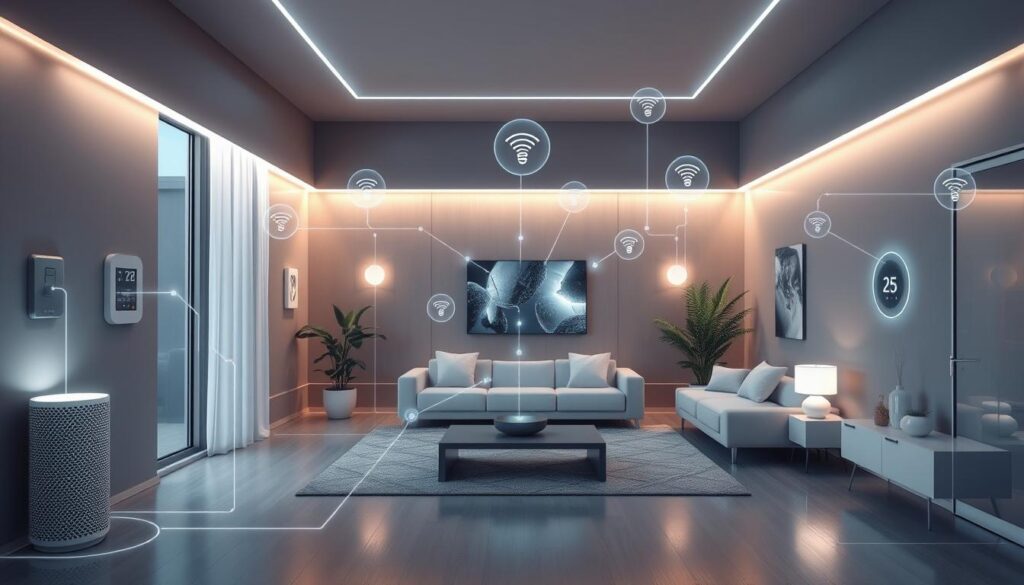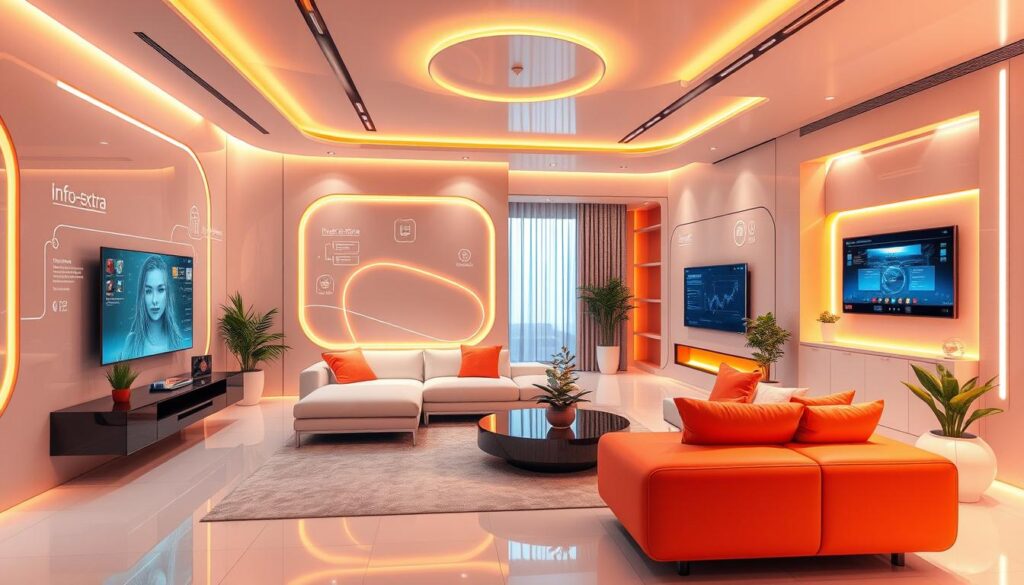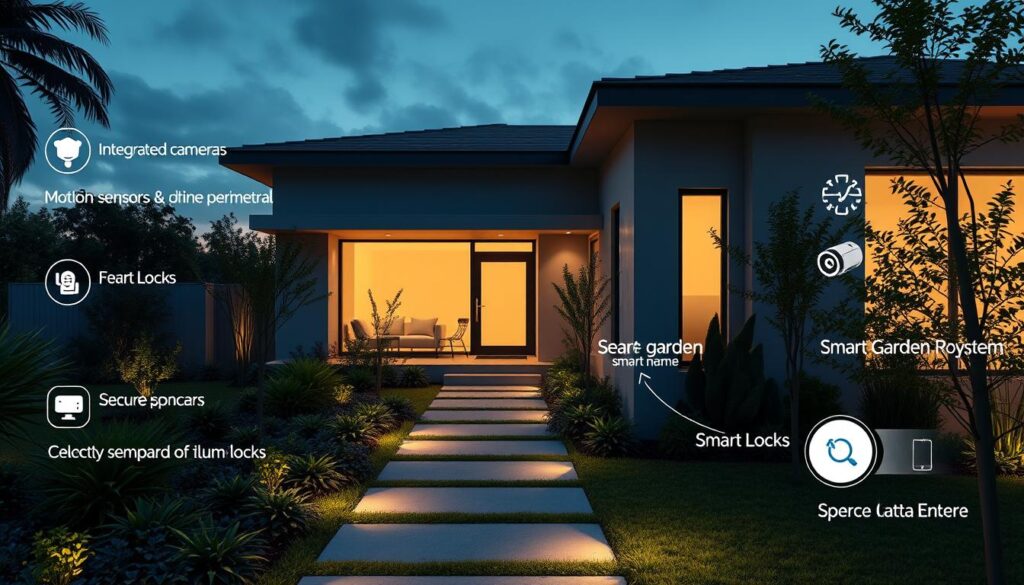The idea of a smart home is now a reality for many families. It’s thanks to the Internet of Things (IoT), which connects devices and lets you control them online. This brings convenience, security, and efficiency to your home. The smart home market is growing fast, expected to hit USD 534.4 Billion by 20271.
Smart homes with IoT devices use 10-15% less energy than regular homes2. Also, 85% of homeowners say IoT security systems make their homes safer with real-time monitoring2. IoT appliances can cut maintenance costs by 20-30% by spotting problems early2. Plus, 70% of users find their daily routines easier with remote control2.
The cost to set up IoT in a smart home varies from $2,000 to $15,0002. But, 95% of homeowners think IoT devices improve their life, especially in security and convenience2.
- Smart homes with IoT devices can achieve 10-15% higher energy efficiency compared to traditional homes.
- 85% of homeowners feel IoT-based security systems enhance property safety with real-time monitoring.
- IoT-enabled appliances show a 20-30% reduction in maintenance costs through early issue detection.
- 70% of smart home users report increased convenience with remote device control.
- The initial cost of implementing IoT in smart homes ranges from $2,000 to $15,000.
Unleashing the Power of IoT in Your Home
The Internet of Things (IoT) has changed how we live in our homes. It brings smart home solutions that make life easier, save energy, and keep us safe3.
Key Components of a Smart Home IoT Ecosystem
A smart home IoT system has many connected devices. You’ll find smart speakers, lights, thermostats, security systems, and more. These all work together thanks to a central hub or controller3.
Benefits of Smart Home IoT: Convenience, Energy Efficiency, and Security
IoT in homes brings many benefits. It helps save on energy bills and makes homes safer. Plus, you can control things with your voice or from afar43.
IoT lets you control everything from lights to security with ease. It makes our homes more comfortable and helps us save energy and stay safe5. This technology improves our lives and helps create a better future for all43.
Wireless Communication: The Language of Smart Homes
Smart homes use wireless communication protocols to connect devices smoothly6. Protocols like Wi-Fi, Bluetooth, and Zigbee are key. They let devices talk and share data easily6. These technologies work with IoT to connect more devices, from thermostats to kitchen appliances6.
Mobile apps make controlling smart homes easy6. Users can adjust thermostats and check cameras from anywhere6. Smart home systems also let users automate and personalize their homes6.
Security is vital in smart homes7. Z-Wave, a leading wireless control, offers three security levels7. Using no security can risk user data and privacy7. Strong encryption is key to keep homes safe6.
“Wireless communication protocols like Wi-Fi and Bluetooth are the unsung heroes of smart home technology, enabling seamless connectivity and control.”
Wireless protocols are crucial for smart homes’ future8. New standards like Matter are making homes more connected and secure8.
You can explore further :

Smart Homes IoT: Intelligent Integration for Enhanced Living
Smart home technology is getting better, thanks to the Internet of Things (IoT). Now, we can manage our homes in new ways. Voice-activated assistants and energy-saving systems are making our lives easier and greener.
Voice-Activated Assistants: Smart Homes Obey Your Voice
Amazon Alexa and Google Assistant are at the heart of smart homes9. They listen to our voice commands. This lets us control devices, play music, and set reminders easily. It’s all about using our voice to control our homes.
Energy Efficiency and Sustainability: A Greener Future for Homes
Smart homes are changing how we use energy9. They help us save energy and money10. Smart thermostats and lights can cut energy use by a lot.
These changes are good for our planet and our wallets10. The future of smart homes looks bright, with more tech making our homes better for us and the planet910.

| IoT Solution | Energy Savings |
|---|---|
| Smart Thermostats | Up to 12% on heating, 15% on cooling |
| Smart Lighting Systems | Up to 60% reduction in energy consumption |
“The integration of IoT technology in smart homes is not just about convenience – it’s about creating a more sustainable and energy-efficient future for our living spaces.”
The smart home market is growing fast, expected to hit $135 billion by 202510. With more tech, our homes will keep getting smarter. Voice control and energy-saving features are just the start of what’s possible.
Safeguarding Your Haven: IoT-Powered Security and Wellness
Smart home technology is getting better, and people are using the Internet of Things (IoT) to make their homes safer and healthier. These smart systems make life easier and offer top-notch protection and care for everyone living there.
Improved Security and Safety: Peace of Mind for Your Smart Haven
Today’s smart homes use advanced IoT solutions to boost security. They have connected cameras, motion sensors, and smart locks. These work together to watch over your home in real-time and let you control it from anywhere11.
In emergencies, these smart systems can quickly alert authorities, turn on lights, and unlock doors. This helps first responders get to you fast11.
Health and Wellness: Smart Homes Taking Care of You
Smart homes also help with health and wellness. They offer personalized advice, reminders for medication, and monitor the environment. This helps people take better care of themselves11.
For example, wearable devices can track important health stats. They can connect with your smart home to give you insights and advice. This helps keep you physically and mentally healthy11.
The future of smart homes will blend security and wellness even more. With more IoT devices being used, homes will become true havens of comfort and safety12.

Conclusion: Embracing the Future of Connected Living
Technology keeps getting smarter, and so will our homes. Soon, smart homes will guess what we need and adjust on their own. This means better comfort and less waste13.
Our homes will also get safer, thanks to new security tech like biometrics and AI. This will keep our homes safe and sound13. Plus, smart homes will learn what we like, making our living space truly our own13.
The mix of IoT and edge computing is turning our homes into smart hubs. They’ll make our lives easier, safer, and greener. And they’ll get even better as tech keeps improving1413.,
The future of smart homes is all about ease, efficiency, and personal touch. By using connected tech, we’re entering a new age of smart living. It will change how we live and make our lives better1413.,
Source Links
- Transforming Our Living Spaces: The Rise of Smart Homes Powered by IoT and Edge Computing
- The Smart Home Revolution: How IoT Is Transforming Modern Living
- Empowering the Future: Unleashing the Power of Internet of Things (IoT) in Smart Cities, Homes, and Businesses
- The Electric Revolution: Unleashing the Power of IoT in Electrical Systems — Kato Electrical | Independent Electrical Contractor | Vancouver, BC
- Unleashing the Power of IoT in Your Home – Andaman Asset Solution
- The Future of Smart Homes: Exploring the Internet of Things (IoT)
- Wireless communication protocols for home automation exploring the security and privacy aspects of smart home IoT devices communicating over the Z-Wave protocol
- What is a Smart Home? Everything You Need to Know|Definition from TechTarget
- Smart Homes: Transforming the Way We Live with Connected Living
- Smart Homes Revolution: How IoT is Making Homes Smarter and Safer
- Privacy in IoT: Safeguarding Your Data in a Connected World
- How Secure Having IoT Devices in Our Homes
- AI and Smart Homes: The Future of Coordinated IoT Devices
- Embracing the Future: Transforming Your Home with IoT – Advanced Property Tech Solutions


3 thoughts on “Smart Homes IoT: Transforming Your Living Space”
Comments are closed.